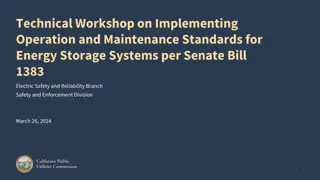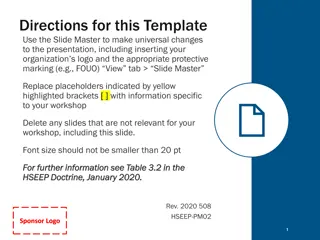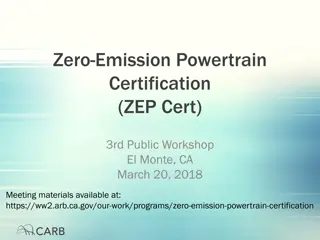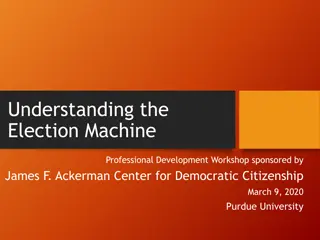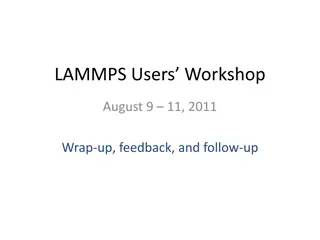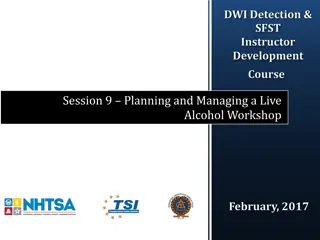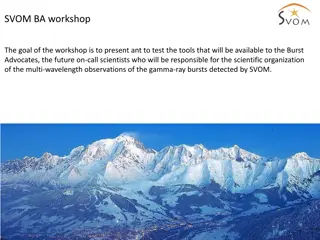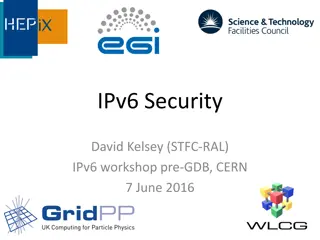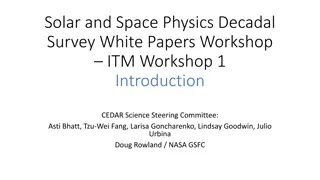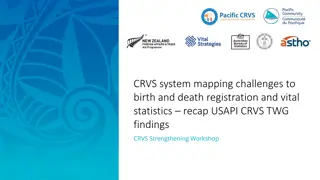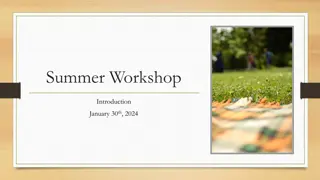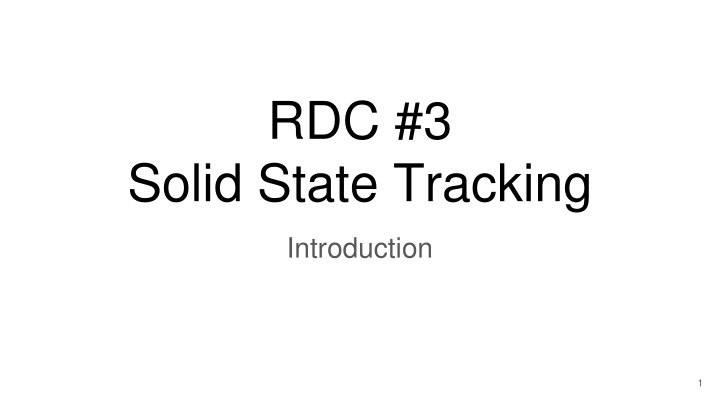
Solid State Tracking Introduction and RDC3 Sessions Overview
Explore the Solid State Tracking introduction, RDC3 sessions schedule, coordinator details, and upcoming meetings. Learn about the goals for the week, community-driven projects, and longer-term R&D priorities. Stay updated with the latest developments in the field of Solid State Detectors.
Uploaded on | 0 Views
Download Presentation

Please find below an Image/Link to download the presentation.
The content on the website is provided AS IS for your information and personal use only. It may not be sold, licensed, or shared on other websites without obtaining consent from the author. If you encounter any issues during the download, it is possible that the publisher has removed the file from their server.
You are allowed to download the files provided on this website for personal or commercial use, subject to the condition that they are used lawfully. All files are the property of their respective owners.
The content on the website is provided AS IS for your information and personal use only. It may not be sold, licensed, or shared on other websites without obtaining consent from the author.
E N D
Presentation Transcript
RDC #3 Solid State Tracking Introduction 1
Welcome We are very excited to see everyone There are three RDC3 sessions: Tuesday 1600-1800: Sensors/modules/interconnections Wednesday 1100-1230: MAPs (joint with RDC4: ASICs) Thursday 1600-1800: LGADs (joint with RDC11: Timing) There are also many sessions related to Solid State Detectors: Tuesday 1330-1600: RDC4: Circuits and Architectures for 4D tracking and calorimeters Wednesday 1330-1600: RDC4 Big Data Management Thursday: 1100-1230: RD10: Mechanics and Cooling Thursday: 1330-1600: RDC4: Methodologies, Tools, IC Block, SoCs, and Workforce Development 2
RDC 3: Solid State Tracking RDC Coordinators Name: Tony Affolder Name: Sally Seidel Dedicated RDC Email List cpad_rdc3@fnal.gov To subscribe: Send an e-mail message to listserv@fnal.gov Leave the subject line blank Type SUBSCRIBE cpad_rdc3 FIRSTNAME LASTNAME (without the quotation marks) in the body of the e-mail message affolder@ucsc.edu seidel@unm.edu Tony Affoder UCSC-SCIPP Silicon Sensors, Modules and Tracking Systems Sally Seidel New Mexico Silicon Sensors, Radiation Tolerance, Trackers 3
Meetings We had an RDC3 Introductory Meeting on Oct. 4th: https://indico.fnal.gov/event/61509/ At it, there was a series of 2-3 page flash-talks where groups got to introduce themselves, what they are doing presently, and their future interests. If you didn t present, please send us a few slides and we will add it to the agenda to collect everyone s interests in one place We are still looking for a good method to gather all our material. We plan to have regular ~quarterly meetings of RDC3 in order to keep in touch, communicate new information, discuss how we are interacting with DRD3, . We may have ad-hoc meetings when necessary for grant planning, . 4
Goals for this week: Improve understanding of the size and interests of the community in order to better organize and start gathering around a few ideas for funding proposals, and common projects RDC3 should be community driven; we want to be facilitators working towards common projects and goals Learn about all the great new ideas and developments in the US There is a notable critical mass around MAPs and LGAD-based systems At the end of these sessions, we have reserved a few minutes to start collecting thoughts on common goals, areas needing development, etc. 5
Longer Term R&D Priorities Directions encompassed in BRN and Snowmass Reports Areas of R&D Priorities Topic Area #1: Adapting non-silicon and novel- configuration sensors Improved costs, area, radiation tolerance, performance Topic Area #2: Scalable, low-mass detector systems MAPs based tracking Topic Area #3: Trackers for Lepton Colliders Similar requirements for timing and spatial resolution Topic Area #4: Trackers for Hadronic Colliders Extreme radiation with fine timing and spatial resolution Topic Area #5: Advanced modeling Table 20 of BRN 6 Key Points from IF03 in Snowmass Instrumentation Report
Our vision of the scope of RDC3 Future systems will be very challenging and require co-design at the early stages to reach the targets our physics goals demand Silo d designs which worked for the LHC and HL-LHC upgrades cannot work in our opinion In the long term, we would like to target larger work packages which will study the topic areas on the previous slide Requires working closely with other RDCs and DRDs at the beginning DRC4 (Readout and ASICs), DRC10 (Detector Mechanics), DRC11 (Fast Timing), ECFA DRD3 (Solid State), ECFA DRD7 (Electronics), ECFA DRD8 (Integration) How we work with the ECFA DRDs is not clear but such collaboration is welcomed on both sides In addition to the sensor elements themselves, we need to make sure we can read them out, support and service the full system. 7
Funding in the near term For the foreseeable future (next 2 years), there is no new earmarked funds within CPAD from the DOE for R&D The presentation of the P5 report at the Dec. 7-8thHEPAP may give some guidance. How to fund our work and the split between the frontiers (R&D, Energy, Intensity, ) is not clear In the next year, only available path is in the FOA: DE-FOA-0003177, section 5F, page 63 for multi-institutional projects At the first RDC3 meeting, we were encouraged to promote: Blue Skies proposals Teams working together more: as in ~2-3 options of common submission to foundries for CMOS MAPs, more common submissions in LGADs and electronics for it Holistic (non-silo d) design and development Because of the above, we propose we pull together a few multi-institutional proposals for submission before September 2024 for Blue Skies or non-experiment specific general R&D for timing and MAPs 8


